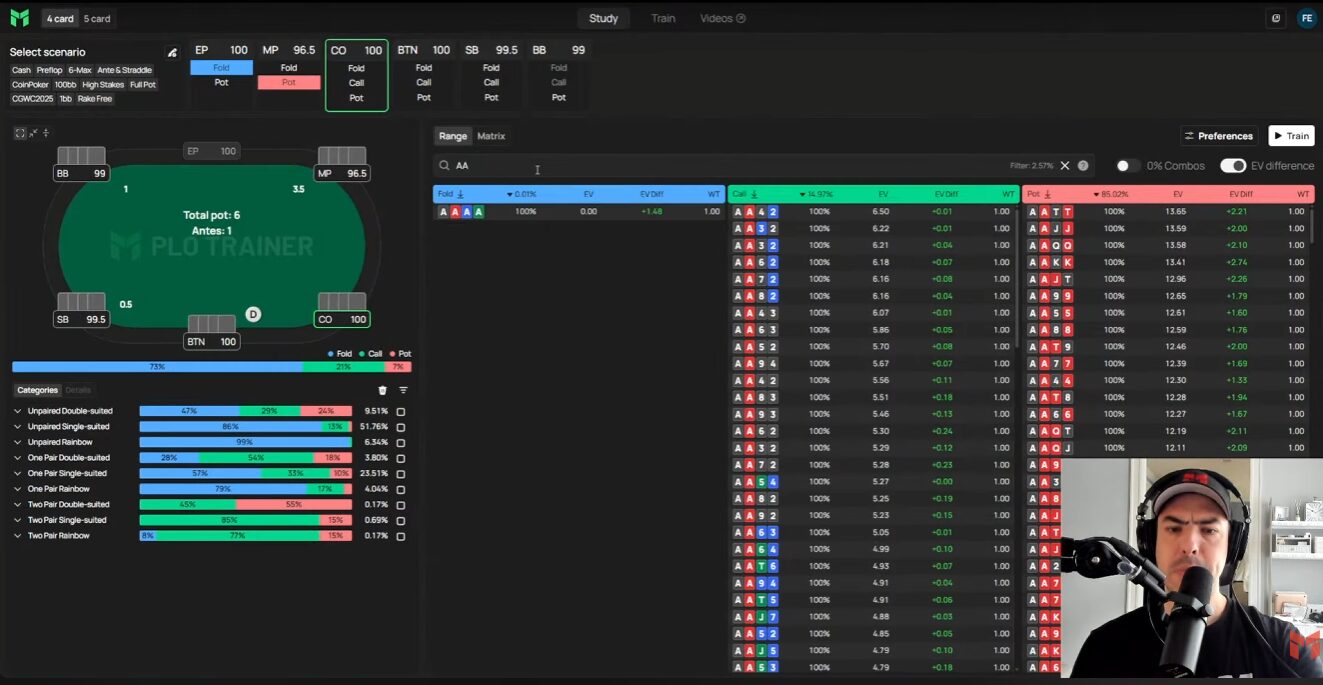
In a new breakdown, JNandez (aka Fernando Habegger) from the Pot Limit Omaha training site PLO Mastermind, pulls hands from the CoinPoker PLO Cash Game World Championship and shows how elite players navigate 3-bet pots in position. If you’re a low–mid stakes grinder—or a NLHE convert dipping a toe into Pot Limit Omaha—this is your fast, no-fluff recap with clear actions you can use tonight. The lens is pure PLO Cash Game Strategy; the tools are the PLO Mastermind library and the upgraded PLO Trainer.
What to look for while you watch
- How he groups boards and ties sizing to texture + SPR.
- Why IP raises are rare vs OOP flop leads on super-connected boards.
- Where thin value lives on rivers—and which two-pair combos become bluffs.
Watch the video here
Rapid-fire takeaways from JNandez’s stream (save these)
- Board class = sizing: Q-7-5 rainbow isn’t an automatic pot; on many mid-connected boards your IP edge comes from seeing turns, not inflating the pot.
- IP raises vs OOP leads are low frequency on 9-8-7/9-7-6: Calling IP retains equity and keeps dominated stuff in.
- Turn aggression spikes on bricks that add equity/blockers: When the turn adds backdoor flushes/overcards (or removes OOP’s nutted combos), fire.
Why: Your range is uncapped and position amplifies fold equity—Fernando Habegger leans on this with geometric planning. - Preflop calibration matters: Not all pretty Broadways are 3-bets vs EP.
Why: Better equity realization → easier postflop decisions—PLO Mastermind hammers this for low–mid stakes. - Exploit for your pool: Many opponents under-lead or over-lead straighty flops. Don’t auto-raise; call wider IP, then punish clean turns.
Why: You’ll print in the exact pools most readers play—yes, even if you’re crossing over from NLHE.
Thread through the whole video: JNandez ties each move back to simple, repeatable templates you can practice in PLO Trainer, and he uses hands from the CoinPoker PLO Cash Game World Championship so we see real-world ranges—not sterile solver trees from a lab-only sim. That’s why this lands for practical PLO Cash Game Strategy.

The core IP blueprint for 3-bet pots (fast explainers)
Preflop: Choose your starting hands wisely
Do: Double-suited rundowns/Broadways, playable AA, high connectivity.
Don’t: Flat single-pair “value” with no backup vs EP opens.
Flop: Size by texture class
Do: Smaller on paired/monotone; mid on ace-high dry; avoid auto-pot on mid-connected boards.
Don’t: Blow up the pot when your hand class wants to see turns IP.
Turn: Pressure on bricks; respect ace-turns that boost OOP
Do: Barrel when you add BDFD/overcard blockers or board-coverage advantage.
Don’t: Spew on turns that hand the nuts back to OOP.
River: Thin value floor + credible bluffs
Do: Value bet where OOP is capped; bluff with nut blockers.
Don’t: Convert weak two pairs without unblockers.
Why this will improve your win rate
- Fewer punt spots. Clear, texture-driven sizing reduces big mistakes in 3-bet IP pots.
- Position compounds. Calling vs OOP leads on dynamic boards maximizes equity realization—straight out of PLO Mastermind and the CoinPoker PLO Cash Game World Championship hand pool.
- Training matches reality. The PLO Trainer “framework sims” (single size) keep it executable for low–mid stakes; then you can layer in mix strategies.
- NLHE → PLO bridge. The blueprint reframes hands into pair-plus-draw logic—how Fernando Habegger teaches Pot Limit Omaha.
Conclusion
In 3-bet pots in position, equity realization and texture discipline beat bravado. Follow JNandez’s templates, drill them in PLO Trainer, and you’ll feel the game slow down. That’s the whole point of PLO Mastermind: simple rules you can execute—across real Pot Limit Omaha pools like those in the CoinPoker PLO Cash Game World Championship—not just solver screenshots.
Key Takeaways
- Texture + SPR decide everything in Pot Limit Omaha 3-bet IP pots.
- IP raises vs OOP flop leads are rare on dynamic boards—call first, attack the turn.
- Brick turns + good blockers = your green light; ace-turns that help OOP = caution.
- Rivers: thin value floor + bluffs with the right unblockers.
- Train with PLO Trainer; learn the why with PLO Mastermind and Fernando Habegger (JNandez).
FAQ
Use one size per class. Smaller on paired/monotone, medium on ace-high dry; avoid reflex potting on mid-connected textures (train this in PLO Trainer).
Stop worshipping top pair. In Pot Limit Omaha, pair-plus-draws and blocker leverage run the show—PLO Cash Game Strategy 101 from PLO Mastermind.
Start with PLO Trainer single-size frameworks, then add mixes after 500 reps. Rewatch the JNandez clips tied to each board class.
As a PLO enthusiast with nearly 12 years of experience, I’m passionate about breaking down the complexities of Pot Limit Omaha, helping you sharpen your strategy and grow your bankroll – no matter your current level. I also share exclusive bonus and rakeback deals, along with discounts on poker courses and tools, so you can get an extra edge. When I’m not writing, you’ll usually find me online, playing PLO cash games and turbo MTTs.

